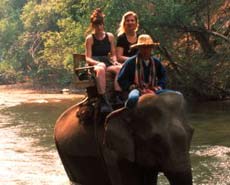Thailand
Background
Ever since the 16th century "Siam" has conjured up images of a sumptuous court life and the mysterious Orient. Modern Thailand is much more than an exotic getaway -- it is a fiercely independent kingdom which, unlike its neighbours, has never been colonised.
Even now, hospitality is a way of life to its proud, resilient people, lending the country its justifiable reputation as the "land of smiles." With its white tropical beaches, mountains, national parks, illustrious history and a strong culture, Thailand can be all things to all people. And although mainstream tourism has arrived in a big way in many areas, a little effort will take you off the trodden path to a land of exceptional geographical and ethnic diversity, of remote villages and glittering temples.
This is a country of kaleidoscopic impressions and colours: a solitary elephant lumbering through the Surin landscape; sprays of delicate multi-coloured orchids; irresistible street food; clouds of butterflies sipping from a country puddle; overflowing monsoon drains in Bangkok; saffron robes in the peace of a temple compound; the ancient ruins of Sukhothai or Ayuttaya.
Highlights
Beaches
Thailand is justly famed for its beautiful beaches, both on the mainland peninsula and the numerous islands -- some developed and some tiny and untouched -- studding the warm waters of the Andaman Sea on the West and the Gulf of Thailand to the east.
At Phang Nga Bay in the south, the sheer limestone outcrops (made famous in the James Bond film "The Man with the Golden Gun"), create one of the most magnificent seascapes in the world.
Bangkok
As far as Bangkok is concerned, the days of being labelled "The Venice of the East" are long gone; most of the city canals are now filled in and have been replaced with gridlocked highways. Bangkok is in a continual state of transformation, with organic tentacles of concrete encroaching daily and ever more surreal high rises appearing each month.
Bangkok is a city of extremes: noisy, polluted, stifling, and overcrowded, where rampant commercialism sits happily beside tranquil temples. An elephant sways past traffic at a standstill in the city centre and easily overtakes -- its baggy grey legs are all that is visible from the stifling bus. It is one of the most happening cities in Southeast Asia, with legendary nightlife.
Sukhothai
The first great Thai kingdom, Sukothai was the centre of the golden age of culture. Founded in 1238, it was the first great Siamese kingdom and soon became a dominant military power and centre for the arts, especially renowned for its beautiful sculptures.
Sukhothai is also famous for its great King Ramkhamhaeng, who is credited with creating the written Thai script, and for establishing Buddhism as the national religion. The city became a vassal of the emerging city of Ayutthaya in 1365 and subsequently relinquished all power.
Ayutthaya
Prince U-Thong, the first ruler of Ayuttaya named it after Rama's legendary kingdom in India. He founded the city in 1350 on an island formed by the confluence of three rivers, surrounded by rice terraces. The first 80 years were spent fighting the neighbouring city of Sukhothai and the Khmers, but Ayutthaya finally sacked the Khmer capital Angkor and went on to become a magnificent city of 1 million inhabitants and hundreds of elegant temples in the Khmer style.
European visitors were dazzled and some compared it with London. Eventually in 1767 the city was pillaged by its long-time enemy Burma and nearly 400 years of occupation was ended.
The Mekong River
One of the 12 greatest rivers in the world, the Mekong runs 4,500km from the Tibetan Plateau (the actual source was discovered in 1995) through China to the Mekong Delta in Vietnam -- where it pours out into the South China Sea.
The river links all the mainland countries of Southeast Asia -- Burma, Thailand, Laos, Vietnam and Cambodia -- and has enormous symbolic as well as strategic and economic significance.
The first European to explore the Mekong was Francis Garnier (1868). His aim was to find a navigable trade route through to China. Unfortunately the Mekong is not fully navigable as the Khone rapids in southern Laos are completely impassable.




